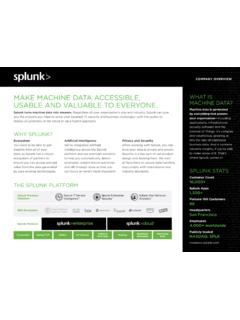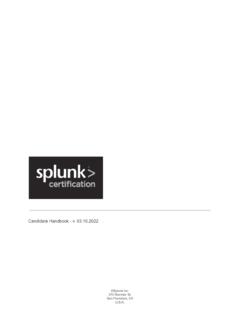Transcription of Splunk Validated Architectures
1 Splunk Validated ArchitecturesJanuary 2021 WHITE PAPERWHITE PAPERS plunk Validated Architectures 1 Table of Contents Introduction .. 2 Document Structure ..2 Reasons to Use Splunk Validated Architectures ..3 Pillars of Splunk Validated Architectures ..3 What to Expect From Splunk Validated Architectures ..4 Roles and Responsibilities ..4 Available Indexing and Search Topologies .. 5 Splunk Cloud Deployment Architecture (CLOUD) ..6 Single Server Deployment (S1) ..8 Distributed Non-Clustered Deployment (D1 / D11) ..9 Distributed Clustered Deployment - Single Site (C1 / C11) ..11 Distributed Clustered Deployment + SHC - Single Site (C3 / C13) ..13 Distributed Clustered Deployment - Multi-Site (M2 / M12)..15 Distributed Clustered Deployment + SHC - Multi-Site (M3 / M13) ..17 Distributed Clustered Deployment + SHC - Multi-Site (M4 / M14).
2 19 Splunk Indexer Architecture Options ..21 Classic Indexer Architecture Using File System SmartStore Indexer Architecture Using Object Storage ..22 Data Collection Architecture ..23 Important Architectural Considerations and Why They Matter ..23 General Data Collection Architecture Guidance ..24 Data Collection topology Overview ..25 Data Collection Components .. 26 (UF) Universal Forwarder ..26 (HF) Heavy Forwarder ..26 (HEC) HTTP Event Collector ..27 (DCN) Heavy Forwarder as Data Collection Node ..29 (IF) Intermediary Forwarding Tier ..30 (KAFKA) Consuming Log Data From Kafka Topics ..32 (KINESIS) Consuming Log Data From Amazon Kinesis Firehose ..33 (METRICS) Metrics Collection ..34 (SYSLOG) Syslog Data Splunk Connect for Syslog (SC4S - recommended best practice).
3 35 Syslog (File monitoring in conjunction with a syslog server)..37 Splunk UDP Input ..38 High-Availability Considerations for Forwarding Tier components ..38 Design Principles and Best Practices .. 39 Deployment Tiers ..39 Aligning Your topology With Best Best Practices: Tier-Specific Recommendations ..39 Search Tier Recommendations ..40 Indexing Tier Recommendations ..41 Collection Tier Recommendations ..42 Management / Utility Tier Recommendations ..43 Summary & Next Steps .. 44 Appendix .. 45 Appendix "A": SVA Pillars Explained ..45 Appendix "B": topology Components ..46 Splunk Validated Architectures 2 Introduction Splunk Validated Architectures (SVAs) are proven reference Architectures for stable, efficient and repeatable Splunk deployments. Many of Splunk 's existing customers have experienced rapid adoption and expansion, leading to certain challenges as they attempt to scale.
4 At the same time, new Splunk customers are increasingly looking for guidelines and certified Architectures to ensure that their initial deployment is built on a solid foundation. SVAs have been developed to help our customers with these growing needs. Whether you are a new or existing Splunk customer, SVAs will help you build an environment that is easier to maintain and simpler to troubleshoot. SVAs are designed to provide you with the best possible results while minimizing your total cost of ownership. Additionally, your entire Splunk foundation will be based on a repeatable architecture which will allow you to scale your deployment as your needs evolve over time. SVAs offer topology options that consider a wide array of organizational requirements, so you can easily understand and find a topology that is right for your requirements.
5 The Splunk Validated Architectures selection process will help you match your specific requirements to the topology that best meets your organization's needs. If you are new to Splunk , we recommend implementing a Validated Architecture for your initial deployment. If you are an existing customer, we recommend that you explore the option of aligning with a Validated Architecture topology . Unless you have unique requirements that make it necessary to build a custom architecture, it is very likely that a Validated Architecture will fulfill your requirements while remaining cost effective. It is always recommended that you involve Splunk or a trusted Splunk partner to ensure that the recommendations in this document meet your needs. If you need assistance implementing a Splunk Validated Architecture, contact Splunk Professional Services.
6 Document Structure SVAs are broken into three major content areas: 1. Indexing and search topology 2. Data collection architecture components 3. Design principles and best practices Indexing and search covers the architecture tiers that provide the core indexing and search capabilities of a Splunk deployment. The data collection component section guides you in choosing the right data collection mechanism for your requirements. Design principles and best practices apply to your architecture as a whole and will help you make the correct choices when working out the details of your deployment. This document contains all SVA topologies that are available at time of publication. For a custom document that meets your specific requirements, please use the Interactive Splunk Validated Architecture (iSVA) tool available here.
7 The custom document will reflect the best practice approach to search, indexing and data collection architecture, given your specific requirements identified when working with the tool. Splunk Validated Architectures 3 Reasons to Use Splunk Validated Architectures Implementing a Validated architecture will empower you to design and deploy Splunk more confidently. SVAs will help you solve some of the most common challenges that organizations face, including: Performance Organizations want to see improvements in performance and stability Complexity Organizations sometimes run into the pitfalls of custom-built deployments, especially when they have grown too rapidly or organically. In such cases, unnecessary complexity may have been introduced into the environment. This complexity can become a serious barrier when attempting to scale Efficiency To derive the maximum benefits from the Splunk deployment, organizations must improve the efficiency of operations and accelerate time to value Cost Organizations are seeking ways to reduce total cost of ownership (TCO)
8 , while fulfilling all of their requirements Agility Organizations will need to adapt to change as they scale and grow Maintenance Optimization of the environment is often necessary in order to reduce maintenance efforts Scalability Organizations must have the ability to scale efficiently and seamlessly Verification Stakeholders within the organization want the assurance that their Splunk deployment is built on best practice Pillars of Splunk Validated Architectures Splunk Validated Architectures are built on the following foundational pillars. For more information on these design pillars, refer to Appendix "A" below. AVAILABILITY PERFORMANCE SCALABILITY SECURITY MANAGEABILITY The system is continuously operational and able to recover from planned and unplanned outages or disruptions.
9 The system can maintain an optimal level of service under varying usage patterns. The system is designed to scale on all tiers, allowing you to handle increased workloads effectively . The system is designed to protect data, configurations, and assets while continuing to deliver value. The system is centrally operable and manageable across all tiers. These pillars are in direct support of the Platform Management & Support Service in the Splunk Center Of Excellence model. Splunk Validated Architectures 4 What to Expect From Splunk Validated Architectures Please note that SVAs do not include deployment technologies or deployment sizing. The reasoning for this is as follows: Deployment technologies, such as operating systems and server hardware, are considered implementation choices in the context of SVAs.
10 Different customers will have different choices, so a generalization is not easily possible. Deployment sizing requires an evaluation of data ingest volume, data types, search volumes and search use cases, which tend to be very customer-specific and generally have no bearing on the fundamental deployment topology . When you are ready, please reach out to Splunk for help with properly sizing your deployment based on your expected ingest and search workload profile. Summary of Current SVA Guidance: SVAs will provide: SVAs do not currently provide: Clustered and non-clustered deployment options. Diagrams of the reference architecture. Guidelines to help you select the architecture that is right for you Tier-specific recommendations. Best practices for building out your Splunk deployment Best practices for connecting to Splunk Cloud Implementation choices (OS, baremetal vs.)









